INTRODUCTION
In previous work we studied the intermolecular associations in liquids through theoretical and experimental studies of the dielectric behavior of binary liquid mixtures [1–4]. In the present work on intermolecular associations in liquids we report measurements of permittivities, refractive indices, and densities for the CCl4+C6H6, + C6H5CH3, and + p−(CH3)2C6H4 mixtures over the whole range of concentrations at 298.15 K. These mixtures are of considerable interest because in them the departures from ideality stems not only from dispersion, dipolar, and inductive forces, but also from the specific interactions that lead to the formation of charge-transfer complexes between the vacant 3D level of the chlorine atom in CCl4 and the π cloud of the aromatic hydrocarbons [5, 6]. In particular the studies of the static permittivity of solutions, measured with high precision, has the advantage that the experimental values are very sensitive to the existence of different interaction products that may be formed in the mixtures [7].
The experimental values of density (ρ), static permittivity (ε), and refractive index for sodium light (nD) can be used to calculate the molar excess volume (VEM), the excess static permittivity (εE), and the excess permittivity at optical frequency (n2ED) over the whole range of concentrations. The excess values for the various mixtures can then be fitted using the Redlich–Kister [8] relation, however this was found to be insufficient, being only descriptive, therefore a model was developed to explain the excess dielectric considering all species present in the mixtures [3]. This previously developed model, based on the additivity of the electrical susceptibilities of the species present in a solution, required the formation of complexes 1:1 in the three systems studied to explain the departures from the ideality. However in the system CCl4+C6H6 this did not seemed to be sufficient making it necessary consider the existence of another type of complex to explain the departure from the dielectric ideality. To perform the theoretical curve, the equilibrium constant values for the interaction products actually formed in the mixtures and the respective electronic polarizabilities and dipole moments can be randomly generated, in order to verify that the values obtained with this method are in concordance with those obtained from measurements of the enthalpy of mixing. It was expected that in this way the existence of other interaction product could be verified.
EXPERIMENTAL SECTION
Materials
Reaction grade compounds were fractionally distilled twice and kept in dark bottles, under dry nitrogen. Benzene, toluene, and p-xylene were refluxed over metallic sodium. Purity was better than 99.9 mol% through gas phase chromatography. In all distillations only the middle fraction coming over at the reported boiling point and comprising about 70% was retained. Density, static permittivity, and refractive indices of the pure liquids at 298.15 K are shown in Table 1 together with literature values.
| Compound | ε Exp. | ε Lit. | nD Exp. | nD Lit. | ρ(g/cm3) Exp. | ρ(g/cm3) Lit. |
|---|---|---|---|---|---|---|
| CCl4 | 2.2279 | 2.2276a | 1.45739 | 1.45734b | 1.58436 | 1.58433b |
| C6H6 | 2.2727 | 2.2730a | 1.49769 | 1.49792c | 0.87372 | 0.87370c |
| C6H5CH3 | 2.3757 | 2.3759d | 1.49405 | 1.49404b | 0.86224 | 0.86224b |
| p−(CH3)2C6H4 | 2.2618 | 2.2612e | 1.49312 | 1.49314b | 0.85673 | 0.85672b |
Measurements
Solutions were prepared by weighing amounts of the pure liquids by syringing them from into stoppered bottles to prevent evaporation and reduce possible error in mole fraction calculations. The mixtures were prepared on a Mettler balance with a 5 × 0−5 g precision. The errors in mole fractions and in the volume fraction are estimated to be less than 1 × 10−4 and less than 1 × 10−4 ml mol−1, respectively. Temperature of all measurements was controlled to within 1 × 10−2 K. Densities were determined with a pycnometer [14] with an estimated error of less than 5 × 10−5 g/cm3. Before making determinations of densities, the pycnometer was calibrated with Millipore quality water. The static permittivity was determined as already described [12] employing the heterodyne beat method. The measurements were made at 100 kHz with an error less then 2 × 10−4 for all concentrations. The theoretical error calculated for the permittivity is 8 × 10−5, however repeated determinations of identical samples gave an actual experimental error of 2 × 10−4 units. This difference originates mainly in small differences in the filling of the cell. During all measurements the dielectric cell was thermostatted to 1 × 10−2 K in a water bath for at least 30 min before experimental measurements. Refractive indices for sodium light were measured on an Abbe type Bausch & Lomb precision refractometer with an error less than 5 × 10−5. In order to keep a constant temperature, the measuring prism was water-jacketed using a temperature controlled bath with a temperature stability of 1 × 10−2 K.
The experimental data of the pure liquids and of the all the solutions were measured four times. The averaged results are listed in Table 2.
| X | Φ | ε | nD | ρ(g/cm3) |
|---|---|---|---|---|
| XCCl4+(1−X)C6H6 | ||||
| 0.0812 | 0.0876 | 2.2719 | 1.49452 | 0.93596 |
| 0.1509 | 0.1618 | 2.2702 | 1.49169 | 0.98869 |
| 0.2197 | 0.2342 | 2.2682 | 1.48894 | 1.04010 |
| 0.2988 | 0.3164 | 2.2655 | 1.48582 | 1.09854 |
| 0.3726 | 0.3921 | 2.2629 | 1.48283 | 1.15231 |
| 0.4880 | 0.5086 | 2.2578 | 1.47819 | 1.23513 |
| 0.5600 | 0.5802 | 2.2543 | 1.47540 | 1.28603 |
| 0.6337 | 0.6526 | 2.2507 | 1.47230 | 1.33747 |
| 0.7216 | 0.7379 | 2.2458 | 1.46879 | 1.39807 |
| 0.8103 | 0.8227 | 2.2408 | 1.46522 | 1.45834 |
| 0.8958 | 0.9032 | 2.2353 | 1.46163 | 1.51561 |
| 0.9502 | 0.9540 | 2.2317 | 1.45945 | 1.55166 |
| XCCl4+(1−X)C6H5CH3 | ||||
| 0.0426 | 0.0389 | 2.3714 | 1.49295 | 0.89036 |
| 0.1038 | 0.0952 | 2.3646 | 1.49126 | 0.93113 |
| 0.1884 | 0.1742 | 2.3544 | 1.48879 | 0.98827 |
| 0.2677 | 0.2493 | 2.3449 | 1.48624 | 1.04262 |
| 0.3567 | 0.3350 | 2.3334 | 1.48349 | 1.10457 |
| 0.4329 | 0.4095 | 2.3230 | 1.48091 | 1.15842 |
| 0.5124 | 0.4884 | 2.3114 | 1.47799 | 1.21543 |
| 0.6018 | 0.5786 | 2.2981 | 1.47460 | 1.28059 |
| 0.6901 | 0.6692 | 2.2841 | 1.47111 | 1.34598 |
| 0.7754 | 0.7583 | 2.2694 | 1.46762 | 1.41023 |
| 0.8652 | 0.8536 | 2.2536 | 1.46371 | 1.47895 |
| 0.9479 | 0.9430 | 2.2379 | 1.45983 | 1.54331 |
| XCCl4+(1−X)p−(CH3)2C6H4 | ||||
| 0.0526 | 0.0417 | 2.2611 | 1.49187 | 0.88703 |
| 0.1246 | 0.1003 | 2.2603 | 1.49012 | 0.92965 |
| 0.2078 | 0.1705 | 2.2596 | 1.48783 | 0.98082 |
| 0.2876 | 0.2403 | 2.2580 | 1.48559 | 1.03138 |
| 0.3734 | 0.3183 | 2.2565 | 1.48302 | 1.08811 |
| 0.4536 | 0.3941 | 2.2543 | 1.48046 | 1.14321 |
| 0.5321 | 0.4712 | 2.2518 | 1.47780 | 1.19927 |
| 0.6208 | 0.5619 | 2.2486 | 1.47453 | 1.26531 |
| 0.7146 | 0.6624 | 2.2445 | 1.47083 | 1.33839 |
| 0.7986 | 0.7565 | 2.2404 | 1.46716 | 1.40693 |
| 0.8643 | 0.8331 | 2.2368 | 1.46418 | 1.46272 |
| 0.9405 | 0.9253 | 2.2319 | 1.46048 | 1.52990 |
RESULTS AND DISCUSSION
The excess values were calculated from experimental measurements of permittivity, density, and refractive indices for the sodium D line by means of the following relations [15, 16]:
wherein MZ, Φ0Z, and X0Z (Z=A,B) are respectively molecular weight, ideal volume fraction, and molar fraction of the components. εID, n2IDD, and VEIDM correspond to the definition of ideal mixtures. Subscripts refer to the pure components A and B.The errors in εE, n2ED, and VEM for all concentrations are respectively less than 4 × 10−4, 3 × 10−4, and 3 × 10−3 ml/mol.
In Table 3 are shown the excess values calculated for the three mixtures with the Equations 1, 2 and 3.
| X | Φ | εE | n2ED | VEM (ml/mol) |
|---|---|---|---|---|
| XCCl4+(1−X)C6H6 | ||||
| 0.0812 | 0.0876 | 0.0031 | 0,0010 | −0.001 |
| 0.1509 | 0.1618 | 0.0048 | 0.0013 | −0.001 |
| 0.2197 | 0.2342 | 0.0060 | 0.0018 | 0.002 |
| 0.2988 | 0.3164 | 0.0070 | 0.0023 | −0.001 |
| 0.3726 | 0.3921 | 0.0078 | 0.0024 | 0.002 |
| 0.4880 | 0.5086 | 0.0079 | 0.0025 | 0.002 |
| 0.5600 | 0.5802 | 0.0076 | 0.0028 | 0.000 |
| 0.6337 | 0.6526 | 0.0072 | 0.0023 | 0.002 |
| 0.7216 | 0.7379 | 0.0062 | 0.0022 | 0.000 |
| 0.8103 | 0.8227 | 0.0050 | 0.0018 | −0.001 |
| 0.8958 | 0.9032 | 0.0031 | 0.0009 | 0.000 |
| 0.9502 | 0.9540 | 0.0017 | 0.0005 | −0.001 |
| XCCl4+(1−X)C6H5CH3 | ||||
| 0.0426 | 0.0389 | 0.0015 | 0.0009 | −0.007 |
| 0.1038 | 0.0952 | 0.0030 | 0.0020 | −0.016 |
| 0.1884 | 0.1742 | 0.0045 | 0.0032 | −0.028 |
| 0.2677 | 0.2493 | 0.0061 | 0.0037 | −0.034 |
| 0.3567 | 0.3350 | 0.0072 | 0.0048 | −0.039 |
| 0.4329 | 0.4095 | 0.0078 | 0.0052 | −0.041 |
| 0.5124 | 0.4884 | 0.0079 | 0.0051 | −0.041 |
| 0.6018 | 0.5786 | 0.0079 | 0.0049 | −0.042 |
| 0.6901 | 0.6692 | 0.0073 | 0.0044 | −0.036 |
| 0.7754 | 0.7583 | 0.0058 | 0.0038 | −0.031 |
| 0.8652 | 0.8536 | 0.0041 | 0.0026 | −0.020 |
| 0.9479 | 0.9430 | 0.0016 | 0.0010 | −0.009 |
| XCCl4+(1−X)p−(CH3)2C6H4 | ||||
| 0.0526 | 0.0417 | 0.0007 | 0.0007 | 0.004 |
| 0.1246 | 0.1003 | 0.0019 | 0.0016 | 0.010 |
| 0.2078 | 0.1705 | 0.0036 | 0.0022 | 0.018 |
| 0.2876 | 0.2403 | 0.0044 | 0.0029 | 0.021 |
| 0.3734 | 0.3183 | 0.0055 | 0.0035 | 0.022 |
| 0.4536 | 0.3941 | 0.0059 | 0.0039 | 0.026 |
| 0.5321 | 0.4712 | 0.0060 | 0.0042 | 0.027 |
| 0.6208 | 0.5619 | 0.0059 | 0.0041 | 0.024 |
| 0.7146 | 0.6624 | 0.0052 | 0.0038 | 0.022 |
| 0.7986 | 0.7565 | 0.0043 | 0.0029 | 0,018 |
| 0.8643 | 0.8331 | 0.0032 | 0.0022 | 0.011 |
| 0.9405 | 0.9253 | 0.0015 | 0.0011 | 0.006 |
Each set of results was fitted through least squares, with all points equally weighted, using the Redlich–Kister [8] equation:
wherein YE represents all excesses (εE, n2ED, and VEM), and C0A represents mole fraction, X0A, or volume fraction, Φ0A, for component A.In each case, the number of coefficients, aj, was established from an examination of the variation in standard deviation, σ, as given by:
where n is the total number of data points and m is the number of coefficients considered.Coefficients, aj, and standard deviations, σ, for the three systems are listed in Table 4.
| YE | a1 | a2 | a3 | σ |
|---|---|---|---|---|
| XCCl4+(1−X)C6H6 | ||||
| εE | 0.03139 | −0.00102 | 0.00754 | 0.00010 |
| n2ED | 0.01061 | 0.00015 | ||
| VEM | 0.0029 | 0.0013 | ||
| XCCl4+(1−X)C6H5CH3 | ||||
| εE | 0.03243 | 0.00019 | ||
| n2ED | 0.02079 | 0.00017 | ||
| VEM | −0.1711 | 0.0010 | ||
| XCCl4+(1−X)p−(CH3)2C6H4 | ||||
| εE | 0.02404 | 0.00019 | ||
| n2ED | 0.01646 | 0.00012 | ||
| VEM | 0.1023 | 0.0013 | ||
Figures 1–4 show the experimental values of εE, n2ED, and VEM for the three systems as a function of molar concentrations, as well as the curves calculated with Equation 4.
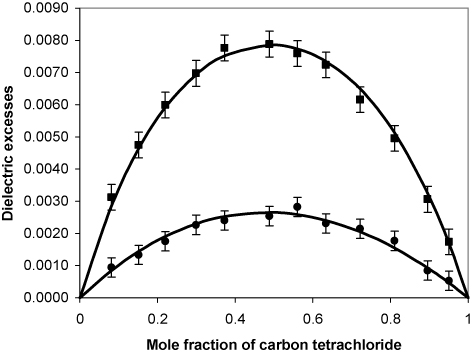
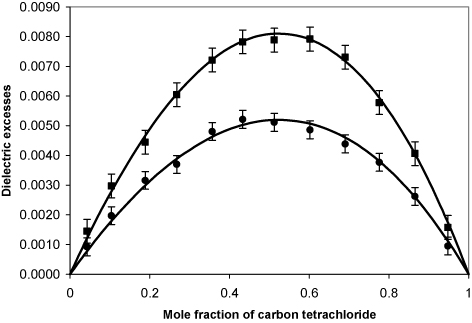
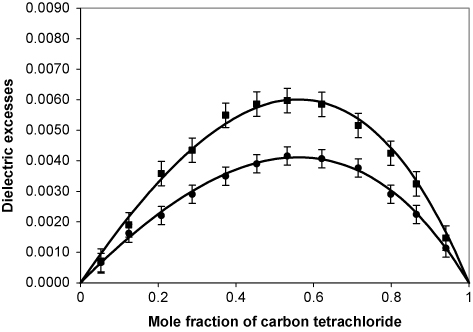
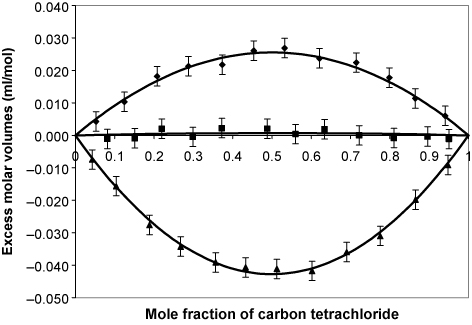
Careful examination of the Figures 1–4 and Table 3 shows that the largest departures from ideality occur around equimolar concentrations, although there exists a slight asymmetry due to the difference in the size of the molecules. It can also be seen that εE and n2EDare positive over the whole range of concentrations for the three systems. This is not the case with VEM, because it is slightly negative for CCl4+C6H5CH3, slightly positive for CCl4+p−(CH3)2C6H4, and approximately null for CCl4+C6H6.
The magnitude of εE for the solutions follow the sequence: CCl4+C6H5CH3 ≈ CCl4+C6H6 > CCl4+p−(CH3)2C6H4. The experimental data for n2ED follow the sequence: CCl4+C6H5CH3 > CCl4+p−(CH3)2C6H4 > CCl4+C6H6. The absolute values for VEM are sequenced as: CCl4+C6H5CH3 > CCl4+p−(CH3)2C6H4 > CCl4+C6H6.
Figure 5 shows the values of εE−n2ED for the three systems as a function of mole fraction of CCl4. There it can be seen that the differences follow the sequence: CCl4+C6H6 > CCl4+C6H5CH3 > CCl4+p−(CH3)2C6H4, indicating that the difference decreases with the increase in the number of CH3 groups on the aromatic ring. It is interesting to note at this point that an inverse sequence was found by Rosseinsky and Kellawi [17] when they plotted the association constant for complexes of CCl4 with benzene and methyl substituted benzene vs. number of CH3 substituents.
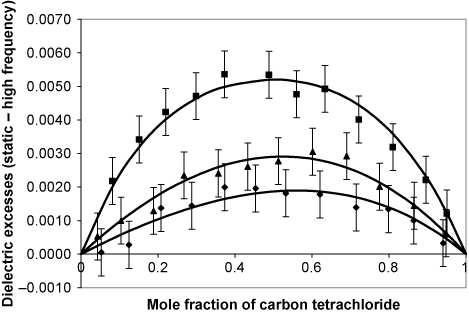
Evidence for the existence of electron-donor-acceptor interactions between CCl4 and the aromatic molecules can be found in the literature through values of enthalpies of mixing or melting points [5, 18, 19]. In dielectric data they can only be observed if high precision measurements are possible because the dielectric excesses in these mixtures are very small. As in this study the static permittivity measurements are of high precision, the interactions between CCl4 and the aromatic molecules could confirm the results found through measurements of enthalpies of mixing and melting points.
To confirm the existence of interactions we use a model that describes the permittivity of a mixture considering the multimers present and the electron-donor-acceptor complexes as separate entities [1, 3, 19]. In principle we can consider a mixture of two non-associated components (A and B) which form a complex AB in the solution. Then in the mixture there are, for every milliliter of solution, NA moles of monomers A, NB moles of monomers B and NAB moles of the complex AB. Consequently the static permittivity and the high-frequency permittivity are expressed as:
wherein αEFZ (Z=A,B,AB) is the effective polarizability of each species, αEFeZ is the effective electronic polarizability of each species and NAV is the Avogadro number.Using the Onsager theory [20] the effective polarizabilities of all the species can be written as:
wherein aZ, μZ, k, and Tare respectively the radius of the sphere that contains the species, the dipole moment of the species, the Boltzmann constant and the absolute temperature.To calculate the radius aZ of the sphere containing species, the volume is assumed as the sum of the volumes of the molecules that constitute the species. Similarly the square refractive index of the species (n2Z) is estimated as the sum of the squared refractive indices of the constituent monomers.
The number of moles of A, B, and AB per unit volume are related by the following expressions:
wherein N0A and N0B represent the number of moles per milliliter of components A and B in the final solution and N represents the total number of moles of the species in the final homogeneous solution.Dielectric excesses, εE and n2ED, can then be written as:
wherein the effective polarizabilities αEFZ and αEFeZ (Z=A,B,AB) are given by Equations (8) and (9).In order to compare the experimental data with the values calculated using the proposed model the values of NA, NB, NAB, αeAB, and μAB are needed. The values of NA, NB, andNAB could be obtained using calorimetric data from equilibrium constant for complex formation [21]. There are two possible ways to calculate the number of species in the solution, the first is writing the equilibrium constant as a function of the number of moles of each species and the second in terms of the mole fractions of the species:
The first association constant is expressed in ml/mol and the second is dimensionless.Both constants are related to each other as shown below:
where XA, XB, andXAB are the mole fractions of the species presents in the mixture defined as: In this work to compute the excesses we follow the following procedure: first values of KXAB and αeAB are generated randomly. When these values fit the excess permittivity at optical frequency (n2ED), within experimental error, random values of μAB are generated. Now the sum of the squares of the differences between the computed and the experimental values for both excesses are minimized. The fits are performed with an iterative method by solving the set of equations: wherein the initial value of NAB is zero and the dipole moments of toluene and p-xylene are taken equal to 0.351 D and 0.148 D respectively.To perform the theoretical curve, in each mixture over 106 random values for KXAB and αeAB were generated. For each pair of values that fit the dielectric excess at high frequency, random values for μAB are generated until the dielectric excess at low frequency is fitted or a maximum of 103 generated values are reached. When this step is completed the process returns to the starting point and starts the fit again. For each mixture 5 total fits were made, therefore 5 values for KXAB, αeAB, and μAB were obtained. In Table 5, mean values and the corresponding errors are shown. The error is determined using the values of the parameters obtained in each of the 5 total fits. The error shown in Table 5 was calculated as half of the difference between the maximum value and the minimum value taken by each of the three parameters.
| Complex | KxAB | αeAB × 1023 (ml) | μAB (Debye) |
|---|---|---|---|
| CCl4:C6H6 | 0.199 ± 0.005 (0.215) | 2.135 ± 0.002 | 0.441 ± 0.002 |
| CCl4:C6H5CH3 | 0.377 ± 0.002 (0.413) | 2.330 ± 0.001 | 0.492 ± 0.001 |
| CCl4:p−(CH3)2C6H4 | 0.558 ± 0.002 (0.556) | 2.515 ± 0.001 | 0.294 ± 0.001 |
The values in parenthesis in the second column were obtained from measurements of the enthalpy of mixing [21] and show reasonable agreement with those obtained in this work. In the system CCl4+C6H6 the excess dielectric points at low frequency cannot be fitted by the model considering only a 1:1 complex. In the other two systems the experimental data and the model agree in the whole concentration range. It should be clarified here that if the 1:1 complex is not considered, in the three mixtures, the model gives values of static permittivity and high-frequency permittivity that are similar to those of the ideal mixture and therefore the excesses are zero.
Experimental values and the curve generated with the model are shown in Figures 6–8 using the parameters given in Table 5.
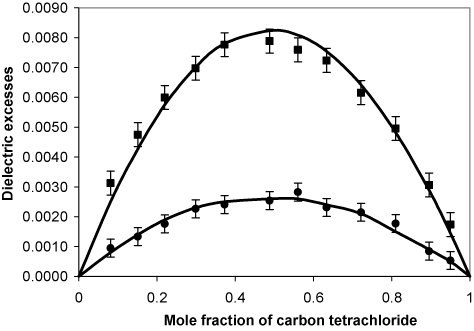
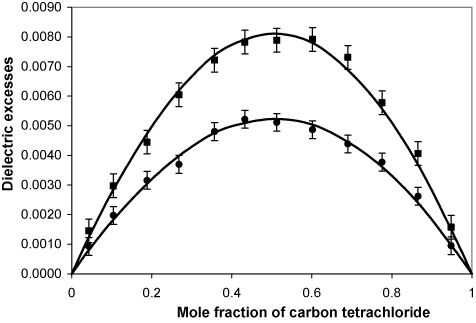
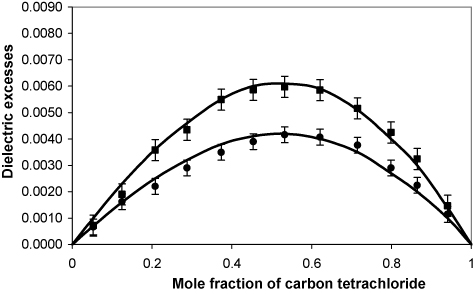
As mentioned above, in the system CCl4+C6H6 the dielectric excesses at low frequency cannot be fitted in the CCl4 low concentration if only a 1:1 complex is considered. Figure 6 shows that at low concentration in CCl4 the experimental data show values higher than those calculated with the model. This could be because in addition to the CCl4:C6H6 complex there exists a CCl4:2C6H6 complex that increases the excess value in the range of concentrations where this species is important. Then, to explain the departure from the ideality in this system, we can consider a mixture of two non-associated components (A and B) forming the AB and A2B complexes in the solution. Then in the mixture there are for every milliliter of solution: NA moles of monomers A, NB moles of monomers B, NAB moles of the complex AB and NA2B moles of the complex A2B. In this case, the static permittivity and the high-frequency permittivity are expressed as:
The amounts of monomers and complexes in the final solution are related by the following expressions: The number of species in the solution is calculated using the equilibrium constants of the complexes that are given by the following relations: To perform the theoretical curve of this mixture over 106 random values for KXAB, KXA2B, αeA2B, and αeAB were generated. Whenever the above parameters fit the dielectric excess at high frequency, random values for μAB and μA2B are generated until the dielectric excess at low frequency is fitted or a maximum of 103 values generated are reached. When this step is completed the process returns to the starting point and start the fit again. For this mixture five total fits were made and in Table 6 the mean values and the corresponding errors are shown.| Complex | KxAB | KXA2B | αeAB × 1023 (ml) | αeA2B × 1023 (ml) | μAB (Debye) | μA2B (Debye) |
|---|---|---|---|---|---|---|
| CCl4:C6H6 | 0.19 ± 0.02 | 2.134 ± 0.004 | 0.433 ± 0.006 | |||
| CCl4:2C6H6 | 0.15 ± 0.05 | 3.172 ± 0.007 | 0.52 ± 0.05 |
The values of NA, NB, NAB, andNA2B are obtained with an iterative method by solving the set of equations:
where the initial values of NAB and NA2B are zero.Figures 9 and 10 show the calculated curves for both dielectric excesses using the values given in Table 6. The experimental results were not fitted within the experimental error when only the CCl4:C6H6 complex is considered, however when the CCl4:C6H6 and CCl4:2C6H6 complexes are considered all the experimental points are fitted according to the model. The chi-square value is 8.37 when only the complex CCl4:C6H6 is considered and 6.73 when the CCl4:C6H6 and CCl4:2C6H6 complexes are considered. The expected maximum values are respectively 16.919 and 12.592 for 9 and 6 degrees of freedom. Therefore the hypothesis with α = 0.05 is not discarded. There is no clear differences between the two values to ascertain the existence of the two complexes, but now the theoretical curve passes through all points, within the experimental value. This leads to think that the two complexes could exist and this should be verified through other methods.
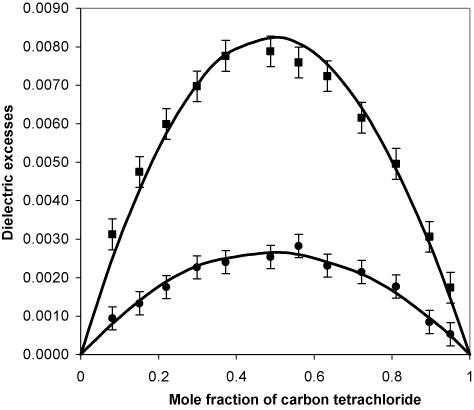
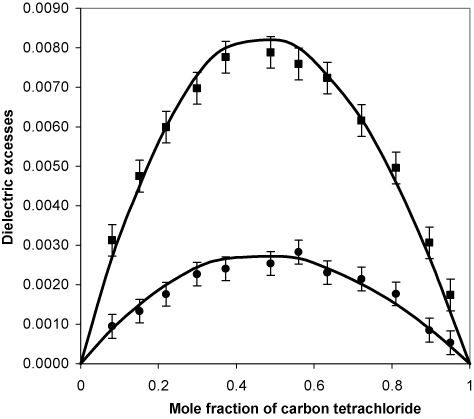
It should also be mentioned that the relative errors in the parameters when the CCl4:C6H6 and CCl4:2C6H6 complexes are considered are all larger than in the case wherein the existence of a CCl4:C6H6 complex is considered to exist. This is so because there are several relative minima close to the absolute minimum when the best values of the parameters are generated randomly.
CONCLUSIONS
High precision permittivity values measured in this work made it possible to calculate dielectric excesses with a model indicating that CCl4 forms intermolecular complexes with benzene (C6H6), toluene (C6H5CH3) and p-xylene (p−(CH3)2C6H4).
This is achieved by using a model based on the additivity of the electrical susceptibilities of the species present in a solution that allows to calculate the dielectric excesses of a homogeneous mixture at different frequencies and in the whole range of concentrations. The excesses calculated in this work agree with the experimental values only when complex formations are considered in the mixtures. In particular, in the CCl4+C6H6 system the behavior of the dielectric excess at low frequency can only be explained if the CCl4:C6H6 and CCl4:2C6H6 complexes are considered to be present in the mixture.
The most important and valuable characteristic of this treatment is that the method of generates easily random values of the various unknown parameters needed in the model to predict the dielectric excess of a mixture, can fit the experimental data. When only the 1:1 complexes in each mixture are considered, the randomly generated parameters that best fit the experimental data are in reasonable agreement with those of the literature. Therefore when other complexes are present this method allows to obtain a theoretical curve that has a good fit with the experimental results, confirming the need to consider the existence of interaction products, other than those of a 1:1 relation when systems of this kind are considered.
